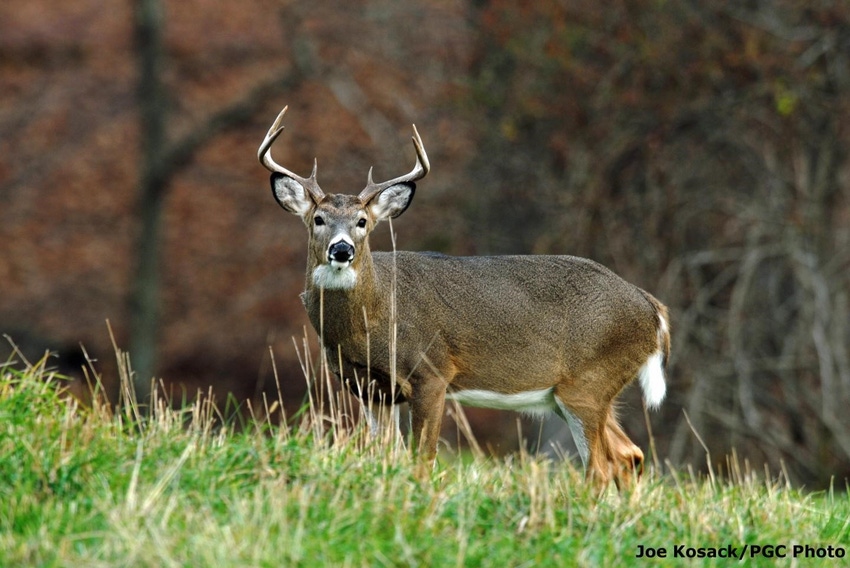White-tailed deer in the northeastern U.S. more susceptible to CWD than those in the western U.S.
June 7, 2019

Some deer are more susceptible to chronic wasting disease (CWD) that is spreading through herds of white-tailed deer across much of the U.S., according to researchers with the Pennsylvania State University.
The researchers have identified a panel of genetic markers that reliably predict which animals are most vulnerable to the contagious neurological disorder, an announcement from Penn State said.
"The genetic variants that would make deer less susceptible to chronic wasting disease are in much lower frequency in the East, likely because they weren't needed," said David Walter, adjunct assistant professor of wildlife ecology. "Over a long period of time, their survivability may have been somehow favored by losing these genotypes. They weren't important until a disease like chronic wasting disease showed up. We have seen that deer with the more susceptible genotypes are in the majority."
Over the last decade or so, Walter's research group in the Penn State College of Agricultural Sciences has been studying how the movement, behavior and genetics of wild deer are affecting the spread of CWD, a fatal prion disease affecting the deer family that belongs to a group of similar diseases known as transmissible spongiform encephalopathies.
After testing more than 2,200 deer killed by hunters in Virginia, West Virginia, Maryland and Pennsylvania, the researchers identified 11 different subpopulations of deer in the Mid-Atlantic region where a CWD outbreak is occurring. The researchers used than 700 DNA samples from Pennsylvania deer to assess genetic susceptibility to the disease in the subpopulations, and those results were published earlier this year in the journal Prion.
"Deer in the Mid-Atlantic region have a higher proportion of the genotypes most susceptible to CWD than deer populations to the west that have been tested in other states," Walter said.
He noted that the disease was first seen in mule deer in Colorado in 1967 and has been spreading eastward across the continent since. It now infects deer and elk in 24 states and several Canadian provinces and has been found in reindeer, moose and red deer in three Scandinavian countries.
"In the U.S., CWD spreads differently in the East than in the West, because deer numbers and densities are so much higher in the East," said Walter, assistant unit leader of Penn State's Pennsylvania Cooperative Fish & Wildlife Research Unit. "We have been trying to unravel the genetic nuances to understand where chronic wasting disease is likely to show up."
In earlier published studies, Walter and colleagues determined that geographical features such as rivers, mountain ranges and high ridges have channeled CWD spread in the East. Even manmade features such as highways appear to have influenced deer movement, guiding where CWD in deer has been discovered.
The Walter group's latest research consolidates the numerous genetic resources for white-tailed deer into a manageable panel of 11 genetic markers to provide a uniform methodology that is likely to improve genetic comparisons, Penn State said. Researchers reviewed "microsatellite" panels from 58 previous or ongoing studies of deer in CWD outbreaks in other regions.
In findings published June 6 in BMC Genetics, they describe a protocol to differentiate subpopulations of deer and evaluated its efficacy using 720 DNA samples collected from whitetails in the Mid-Atlantic region. In the study, researchers analyzed 2,200 samples from deer in four states to evaluate microsatellites.
"The 11 markers we selected are easy to interpret and are likely to provide a common platform to benefit future genetic studies such as those for CWD," said lead researcher William Miller, former Penn State doctoral student, now an assistant professor of biology at Calvin College in Michigan.
Miller pointed out that many genetic studies conducted previously used different suites of genetic markers.
"We wanted a core panel that will be broadly useful and effective across the white-tailed deer's range, and we included many of the markers that have been used in studies from states in the Midwest and West," Miller said. "This panel includes markers that are likely to be useful for evaluating genetic patterns."
Follow-on studies nearly complete by Miller and Walter's lab outline a genetic method to determine when a CWD-positive deer is discovered, where it came from and whether it is a wild or captive-bred animal, the announcement said. That information will guide wildlife managers' reaction to the discovery, as they decide whether to establish disease-management areas and targeted removals of deer to slow the spread of CWD.
Also involved in the research were Jessie Edson, genetics laboratory manager in Penn State's department of ecosystem science and management; and Peter Pietrandrea, undergraduate researcher, and Cassandra Miller-Butterworth, assistant professor of biology, both at Penn State Beaver. The Pennsylvania Game Commission, the Maryland Department of Natural Resources and the Virginia Department of Game & Inland Fisheries supported this research.
You May Also Like



